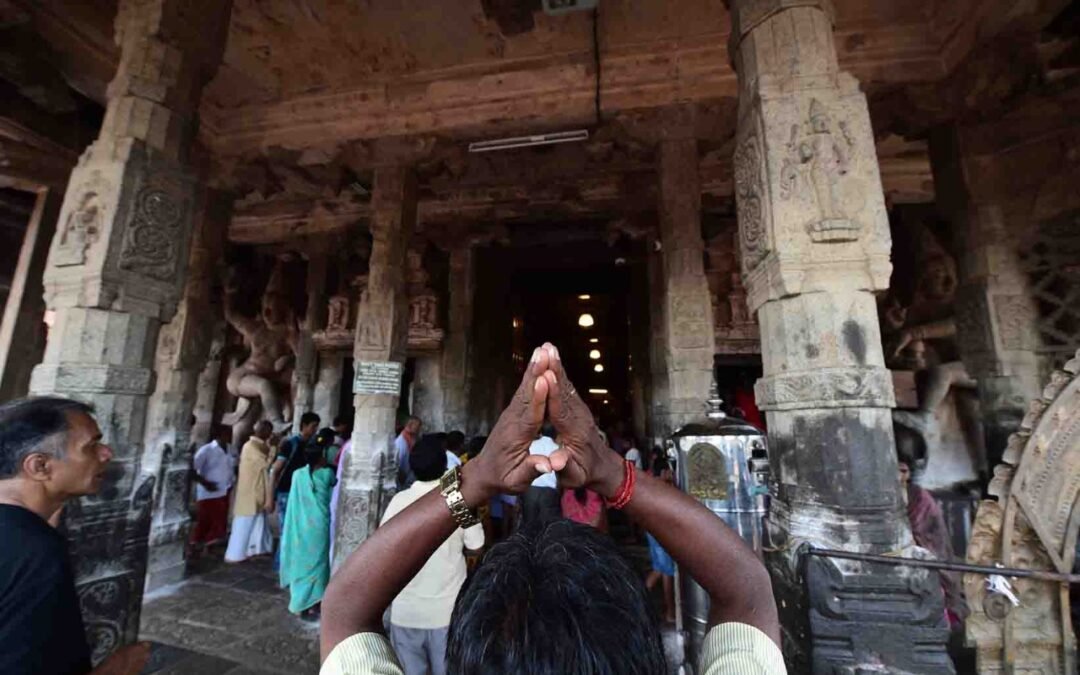Read in : தமிழ்
What is the true identity of Tamils? Are they not Hindus?
To answer this question, we have to look at what leads to confusion regarding this question. The legacy of the British, our education system, lack of understanding of Indian heritage and cultural roots, misinterpretation of historical facts, and mishandling of truths have led to commotion in Tamil society regarding its true identity.
It’s like the story of six blind men. The first blind man touched the side of the elephant and felt it was smooth and solid like a wall. The second touched the trunk and called it a giant snake. The third touched the tusk and thought it was a spear and so on.
As far as the conceptualization of the Hinduism is concerned, it is often misinterpreted by those who don’t have deep historical, cultural and spiritual knowledge of this soil. They don’t understand that the very concept of rationalism and atheism has been a part and parcel of Sanatana Dharma which has been renamed as Hinduism for convenience or reasons unknown. “Sanatana Dharma” itself is not a religion and it is only a way of life for all human beings.
The very concept of rationalism and atheism has been a part and parcel of Sanatana Dharma which has been renamed as Hinduism
Sanatana Dharma had two branches connected to belief in God, viz., Pravruthi Marga (Belief in God) and Nivruthi Marga (Atheism). Sanatana Dharma has been balancing the arguments of the Nivruthi Margis by bringing rational amendments and suitable changes in its system. As a result of this process, many great saints like Adi Sankara, Madhvacharya and Ramanuja advocated their philosophies of Advaita, Dwaitha and Vishitadwaitha which led to the spread of Bhakthi throughout the nation.
It is a well-known fact that Bhakthi started from the south as a movement. The “Madras State” of those days consisted of many of the landscapes of the present states of today. Hence to disown Sanatana Dharma just by neglecting its ancient history will do great havoc to the future generation which will be forced to live in a confused state of mind just because of divisive forces of today.
It is evident from history and literature that the five landscapes of Tamils worshipped gods such as Mayon (Vishnu), Cheyon (Lord Murugan), Varuna and Kotravai (a form of Mahakali). It is also documented through literature that the Tamils of all the five landscapes had specific rituals and way of praying to the gods. “Sangam Maruviya Kalam” had a nomenclature of “Irundakalam” as it lacked clarity of history facts. It can nevertheless be said Tamils traditions are very much a way of life in Sanatana Dharma.
It should be noted that the entire Tamil region, its people, kings and poets have followed the path of Bhakthi. Even today the temples of Tamil Nadu stand as true evidences of the devotional and spiritualistic heritage of this region.
Bhakthi thrives in Tamil Nadu today despite the avowed atheism and rationalism of political parties. Our temples such as in Palani are among the most visited in all of India.
Tamil region has been witnessing a lot of tussles due to anti-Hindi protests of regional parties but the situation has changed in recent years. Though a section of the people still connect themselves to those emotions, a majority of the Tamil people do not subscribe to the ideas anymore. Even the political parties who were raising slogans against the Hindi language have changed their stand and say they are only against Hindi imposition.
Government school students are denied of opportunities to learn Hindi even if they wish to learn the language. Everyone accepts that no language should be imposed. This means the poor and underprivileged students of government schools should be given the opportunity to learn the language if they wish to do so. Those who don’t want to learn should not be compelled.
Jallikkattu protests succeeded since it was a noble effort of the youth to preserve ancient traditions and had the support of people around the world, as well as the then state and Union governments. Respecting and honouring the bull is an example of respecting all creation practiced in Sanatana Dharma much like how the cow is a sacred animal across India. This is unlike bullfighting events such as in Spain where the bull is often killed at the end.
The socio-political environment of Tamil Nadu has drastically changed over decades. But Tamil land has retained its identity as a place of temples, divinity and Bhakti.
(The author is writer, social commentator)
MATCHUP
Tamils are Tamils, not Hindus. No space for BJP here
In most states including in formerly Left-ruled West Bengal, Hindutva as a political ideology has struck roots. In Tamil Nadu, however, the same success has been hard to achieve for the BJP despite campaigns such as the Vel Yatra undertaken before Assembly...
Read in : தமிழ்












